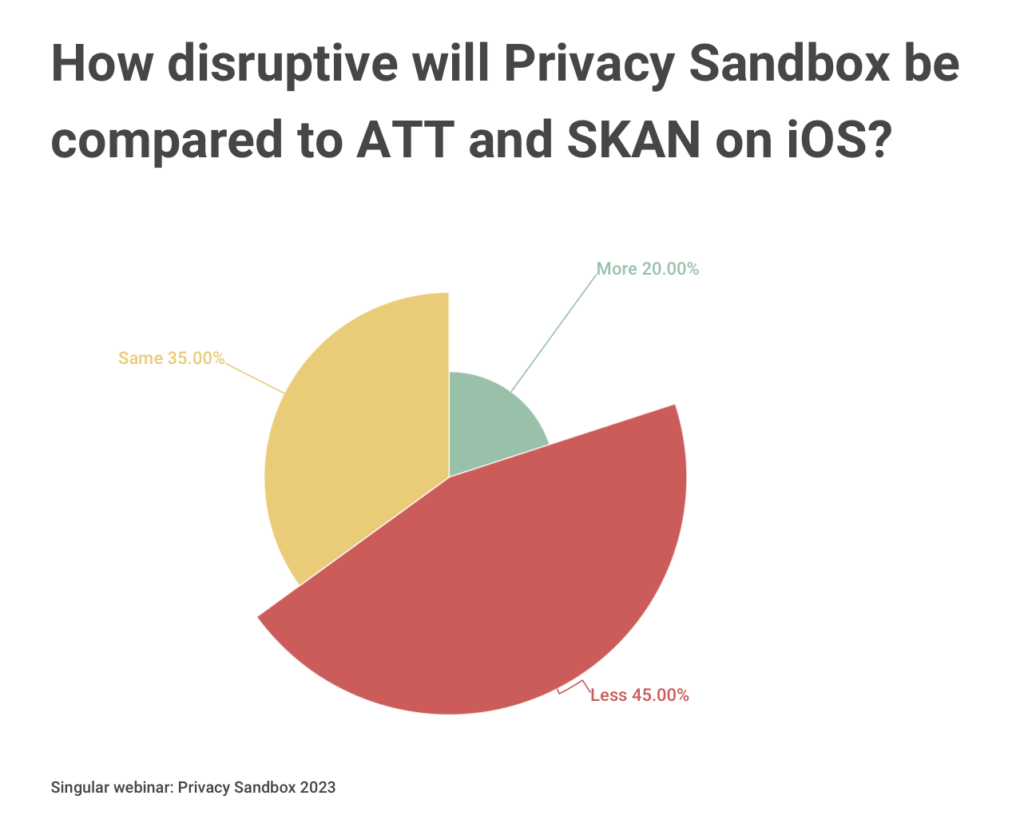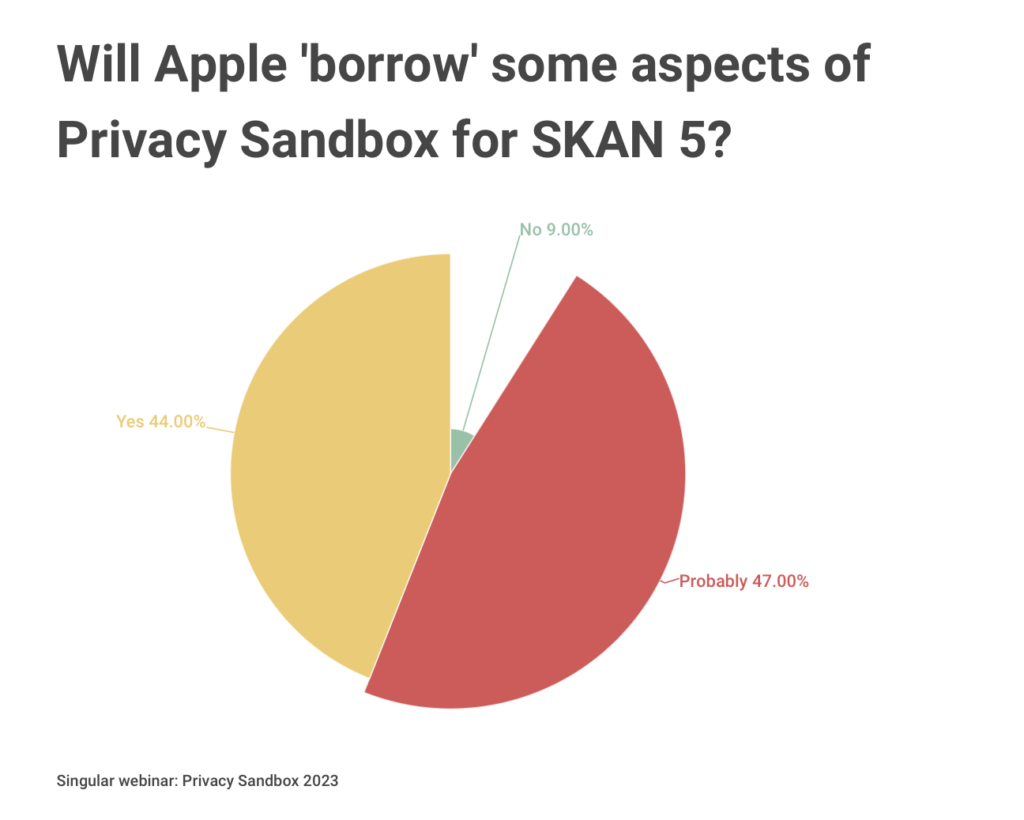Privacy Sandbox on Android: from black box to sandbox, thanks to a 360-degree advertising suite
45% of marketers say the transition to Privacy Sandbox on Android will be less disruptive than the iOS transition to SKAdNetwork. 35% say it’ll be the same, while 20% think it will be more disruptive.
The majority of marketers might just be right.
Experts say that while Privacy Sandbox on Android will break more things in mobile adtech than ATT and SKAdNetwork did on iOS, the overall effect will be less disruptive. Part of the reason: Privacy Sandbox is a complete advertising suite.

We recently hosted our first webinar on Privacy Sandbox on Android in a long time. Most of our recent privacy webinars have been on iOS, ATT, and SKAdNetwork, but Privacy Sandbox is coming in 2024, and that’s sooner than we think.
The participants:
- Gus Viegas, head of growth at Lessmore
- Claire Rozain, founder at Global Warming Games
- Sergio Serra, product head at InMobi
- Eran Friedman, co-founder and CTO at Singular
Privacy Sandbox on Android: advertising efficiency
The good news is that adtech players and measurement providers such as Singular look to be doing the heavy lifting now to make it at least somewhat easier on advertisers and marketers in the future. The bad news is that advertising efficiency will decrease, just as it has on iOS.
“It will reduce the efficiency of your marketing slightly,” says Lessmore’s Gus Viegas. “But it won’t be a big, big change. It will be, let’s say, 10 or 20% difference from what you’re getting now in terms of efficiency.”
That’s on the one hand comforting — Armageddon is not around the corner, and the campaign devastation many saw in the early days of SKAN 3 likely won’t happen — but on the other hand a cold wake-up slap in the face. If you’re already operating on razor-thin ROAS margins, it’s a call to action to boost efficiency and signal and ROI as much as possible.
Google Referrer stays
There’s a few reasons why Privacy Sandbox on Android will likely be less impactful on marketers.
One is that the Google Referrer is still around.
“It’s basically a mechanism that existed in Android for several years now, specifically for the Google Play Store apps, and also other Android stores that are working on similar mechanisms,” Friedman explains. “When you click a link to the Play Store, you can include what’s called the referrer parameter, and that would be passed to the app once it’s launched. And this mechanism has been used across the board for attribution purposes. So, whenever there’s a user, it came from a specific campaign, you can actually know where it came from, basically based on that Referrer even regardless of the GAID.”
That comes straight from Google’s history on the web, of course, where websites typically get access to the referrer: the site that someone clicked a link on in order to arrive. It helps provide context, start personalization, and provide insight into customer/user/player journeys. In mobile, the referrer can do some of those same things, while also playing a role in marketing measurement.
It never existed on the iOS side, but it has on Android.
And so far, it appears to be staying.
Privacy Sandbox offers more granularity than SKAdNetwork
Another reason: more granularity.
“You are going to have a really good granularity in your data into the reports you’re going to have aggregated on the Google side,” Global Warming Games founder Claire Rozain says.
While there isn’t a huge amount of data down-funnel, you will get multiple conversion events extending out to 30 days. And upper-funnel data will be truly rich: event-level reports will provide a super granular breakdown of your upper-funnel data (think campaign, sub-campaign, creative, down to the click_id itself), as Singular CEO Gadi Eliashiv has said.
Targeting, retargeting, attribution, and more
Yet another reason Privacy Sandbox on Android won’t be as disruptive: as an ad network, Google has built Privacy Sandbox on Android to function in an adtech and marketing context.
The downside is that it will break more, InMobi’s Sergio Serra says. That’s because it’s a full suite for much of what needs to happen in advertising.
“In my mind, Privacy Sandbox for Android is going to be more breaking than SKAN, in a way, but less disruptive,” Serra said. “What I mean by this is that Privacy Sandbox for Android is a complete advertising suite … it goes 360 degrees from targeting, retargeting, fingerprinting crackdown, and attribution.”
As ironSource’s Yevgeny Peres told me on the Growth Masterminds podcast almost a year ago, Privacy Sandbox for Android is a much fuller-featured ad technology than Apple’s ATT and SKAdNetwork. That means the ecosystem has more pieces to pick up and more tech to build around the way Google is reinventing each of those aspects.
But it also means that hopefully, the burden will be on the ecosystem partners, not the advertisers and marketers. Which doesn’t mean it will be easy … but most marketers think it will be easier to adapt than it was on iOS with SKAdNetwork.
Interestingly, over 90% of participants in the webinar said that Apple was likely to borrow a few aspects of Privacy Sandbox on Android from Google for SKAN 5, whenever that arrives.

“The core of the thing is that it’s not a disruption, but we’re moving from a black box to a sandbox,” says Rozain.
That’s good, but only 19% of participants said they were “as ready as they could be” for a future without advertising identifiers. So there’s still some significant amount of work to be done.
Stay up to date on the latest happenings in digital marketing


